Note: for the full suite of measurements from the SoundStage! Audio Electronics Lab, click this link.
I’ve reviewed a slew of exceptional integrated amplifiers in the last few years, from the likes of such well-known companies as Anthem, Cambridge Audio, Hegel Music Systems, Lyngdorf Audio, NAD, and Naim Audio. But this latest integrated to arrive is made by Kinki Studio, a Chinese company I’d never heard of. I didn’t know what to expect when Jeff Fritz contacted me about reviewing the EX-M1+, but what Kinki themselves say about it on their website made it seem at least promising. Later, when we posted a picture of the EX-M1+ on the SoundStage! Network’s Instagram feed, I was surprised by how many likes and positive comments it got from those familiar with it.
I shouldn’t have been surprised. The all-analog EX-M1+ is a solidly and attractively built integrated amplifier specified to deliver a whopping 215Wpc into 8 ohms, but is priced at a surprisingly low $2898 (all prices USD). It doesn’t have a lot of features, but its considerable power output and apparently high qualities of design and construction were more than enough to grab my attention, and that of our Instagram followers.
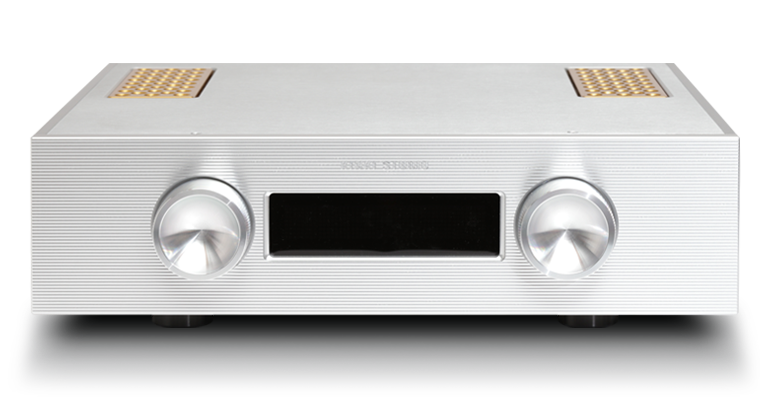
Description
The silver-and-gold case of the EX-M1+ is flashy — in fact, some might think the shiny mirror finish of its front panel is a bit much. However, the top panel of brushed aluminum, with cutouts for the tops of its two gold-colored heatsinks, makes a nice contrast. All that gleam is broken up and muted by small horizontal ridges that run the full width and height of the faceplate. The two large knobs flanking the central matrix display control input selection (left) and volume (right). The left area of the screen displays the input selected, the right side the volume level. The display’s characters are large, bright, and easy to read from across the room — something my aging eyes appreciated. The power button is hidden away at center front on the bottom panel. The EX-M1+ measures 16.9″W x 4.9″H x 14.6″D and weighs 55.1 pounds.
The rear panel is cleanly laid out. At center, in a row across the top, are three pairs of single-ended input jacks (RCA) and one pair of Neutrik balanced inputs (XLR). Below those are RCA jacks for the home-theater bypass input and preamp output. Centered at the bottom is a Furutech IEC power inlet and fuse bay — the manual suggests that you use your own audiophile power cord rather than the “El cheapo” (their words!) cord provided. At far left and right are pairs of five-way speaker binding posts, with enough space to accommodate even very large speaker cables.
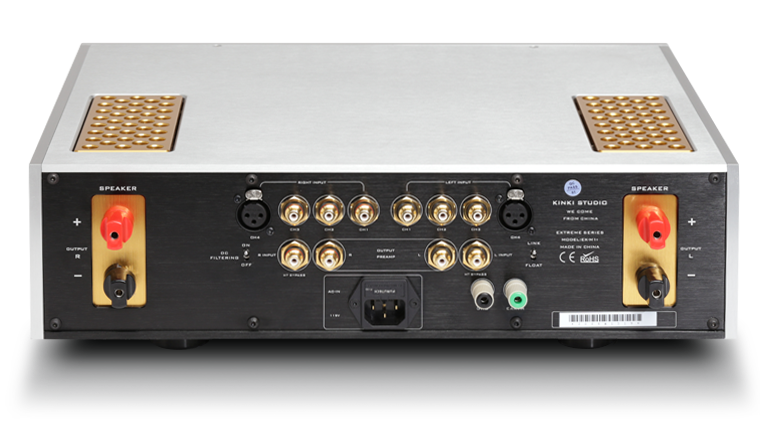
There are also Ground and Earth posts to connect to other components, with a switch to engage or disengage the power earth from the chassis. An AC filter toggle switch lets you engage filtering if you experience DC offset, which can sometimes cause transformers to hum.
The remote control is well made, with solid heft and an attractive brushed-aluminum finish. Fairly small, with rounded corners and edges, it felt comfortable in my hand and was refreshingly simple to use, with a few easily accessible buttons for controlling the volume, mute, input selection, display dimming, output to the speaker and/or preamp outputs, and engaging home-theater bypass. As explained in the EX-M1+’s instruction manual, Kinki doesn’t include the required CR2032 battery, due to shipping restrictions on lithium batteries; you’ll have to provide your own.
Kinki describes the EX-M1+’s power-amp stage as being quasi-monoblock, with dual encapsulated 400VA transformers, WIMA film capacitors, and two pairs of Exicon MOSFETs per channel. The circuit board for each channel’s output stage is mounted on a large, hollow, custom-made, gold-anodized heatsink pierced with ventilating holes. The heatsinks are mounted flush with cutouts in the top panel (to allow for air flow) and in the rear panel, where the speaker terminals are mounted directly on the heatsinks.
Kinki’s specifications: The EX-M1+ delivers 215Wpc into 8 ohms or 4 ohms, with a damping factor of 2000. The signal/noise ratio is >103dB, and the total harmonic distortion plus noise (THD+N) is 0.0232%, or 0.006% A-weighted. Judging by these specs, the quality of the parts, and the tidy, symmetrical layout of the circuit boards, the EX-M1+ seemed to have the makings of a very promising amplifier.
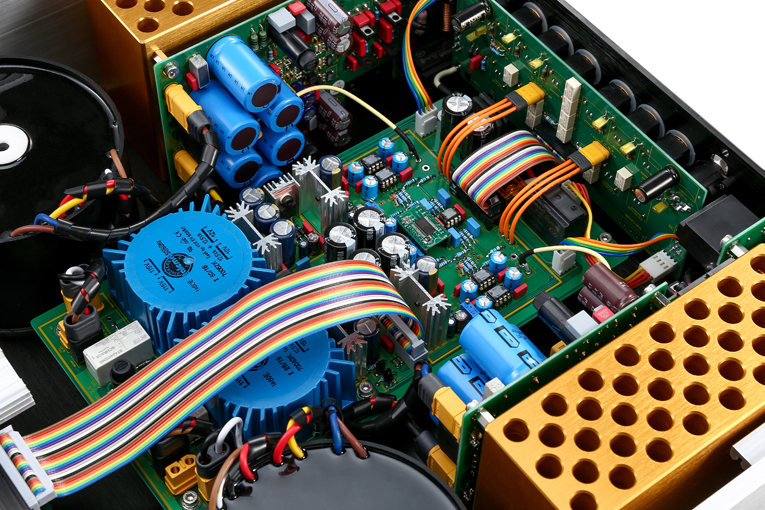
The original EX-M1 was introduced in 2017. The newly updated EX-M1 — without the “+” — costs $2398 and includes, among other things, changes in the power supply, capacitance, and the volume control, the latter now using a MUSES72320 controller instead of the previous relay-based control. The EX-M1+ is essentially identical to the upgraded EX-M1, but adds a preamp-stage output and a home-theater bypass to entirely bypass the preamp stage.
Setup
The Kinki Studio EX-M1+ first spent some time in my second system, which includes an Oppo Digital BDP-105 universal BD player and PSB Alpha T20 loudspeakers, before taking up residence in my reference system: an Oppo Digital UDP-205 4K UHD universal BD player, an Apple MacBook Pro computer running Roon and Qobuz, an AudioQuest JitterBug dejitterer, and MartinLogan Masterpiece Classic ESL 9 loudspeakers. Connecting it all were Clarus Aqua balanced interconnects, speaker cables, and power cords; Nordost Quattro Fil unbalanced interconnects; an AudioQuest Carbon USB link; and power conditioning by Blue Circle Audio and Zero Surge.
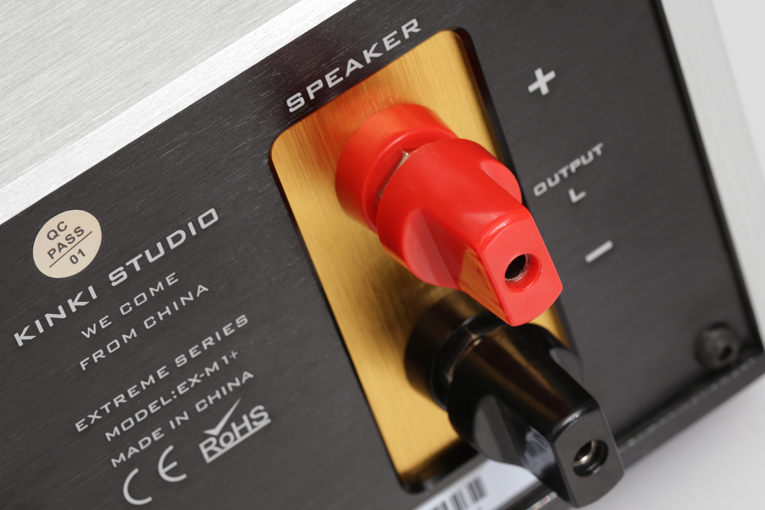
Overall, setup was straightforward and without incident, and the EX-M1+ worked flawlessly throughout my listening period. I had no problems with ground loops or transformer hum, so I didn’t take advantage of the EX-M1+’s grounding options or its AC filter switch for DC offset. Nor did I hook up the Kinki to my home-theater system — but I did try the home-theater bypass, to hear how the EX-M1+ performed as a power amplifier.
Sound
After casually enjoying the EX-M1+ for a week or two by listening mostly to background music, and watching TV and the occasional movie with the PSB Alpha T20 speakers, I moved the EX-M1+ into my main system. While the Kinki Studio EX-M1+ seems to have all the technical qualities of a high-quality integrated amplifier, I was nonetheless a bit surprised by the extremely positive impression it made on me the first time I played music through it and my Oppo Digital UDP-205 BD player and MartinLogan Classic ESL 9 speakers. The sound was so big, bold, and clear that at first I thought I must be overlooking some serious problem, such as an emphasis of one part of the audioband at the expense of another, to create a more engaging sound by hiding a flaw or compensating for a weakness. But as much as I searched for such a shortcoming, I found none.
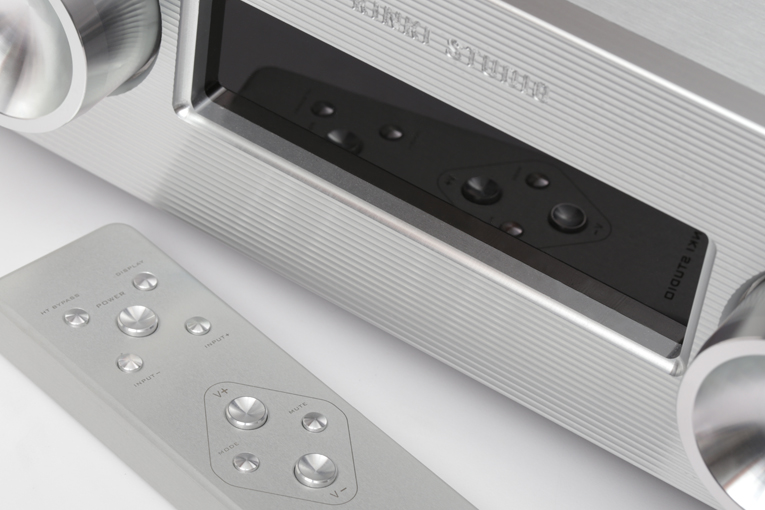
The imaging of “Waba Duba,” from Yello’s Point (24-bit/48kHz FLAC, Polydor/Qobuz), was insanely good, their trademark electronic rhythms and samples bouncing frantically between the speakers. Boris Blank’s synth stylings were impressive — the blat of brass-instrument samples having a satisfyingly visceral effect. The reverb on Dieter Meier’s dark, heavily processed voice as he speaks in “The Vanishing of Peter Strong” gave this track an eerily cavernous quality, while some eccentric, reverb-laden scatting provided aural fireworks in a more light-hearted vein. The EX-M1+ did a fantastic job of revealing the solid foundation of the ever-present low frequencies on every track of Point, while placing voices and instruments very precisely across a wide soundstage. This is an exquisitely crafted album in terms of sound quality — I was astonished at how cleanly the $2898 EX-M1+ was able to reproduce it through the revealing MartinLogans.
The Kinki also conveyed a sense of the size of the orchestral, choral, and solo vocal forces on the recording of Beethoven’s Symphony No.9 with Herbert von Karajan conducting the Berlin Philharmonic, Wiener Singverein, and soloists Anna Tomowa-Sintow, Agnes Baltsa, Peter Schreier, and José van Dam (16/44.1 FLAC, Deutsche Grammophon/Qobuz). In each movement, I could clearly “see” the various sections of the orchestra laid out before me, exactly where I imagined they would be, with a convincing sense of space between them. This was even audible in serene passages in the third movement, Adagio molto e cantabile, in which the sounds of the various string sections can often blend into one. In the final, choral movement, the EX-M1+ unraveled the complex interplay of orchestra, chorus, and solo singers. It was also able to convincingly place a timpani roll well to the back of the hall, with the sotto voce chorus at the very front of the space as they both enter at 10:58. Then, as chorus and orchestra crescendo, the EX-M1+ just kept going and going — it never ran out of steam, never hardened the soloists’ voices, never compressed the sound of any instrument, all while maintaining that magnificent sense of space and distances between players.
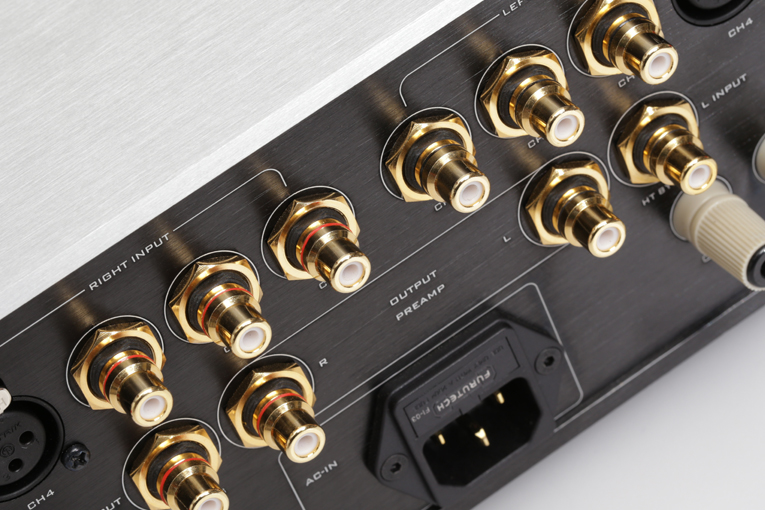
While the size of soundstage and sound that the EX-M1+ was able to reproduce from a recording of full orchestra and chorus was striking, just as captivating was its ability to portray the liveliness and the more intimate space of the Roxy Theatre in “Thunder Road,” from Bruce Springsteen and the E Street Band’s 1975/10/18 West Hollywood, CA (24/192 FLAC, nugs.net). The Boss’s voice, though a little too forward in the mix, was bracing and immediate in a way that captured the urgency of the young Springsteen’s performance.
Comparison
Compared to the NAD Masters M33, which I reviewed in September, when I listened to “Thunder Road” on the EX-M1+, the glockenspiel was emphasized a bit more, was louder in relative volume to the piano, and occupied more of the same recorded space with less delineation between the outlines of the two instruments. With its more neutral and even sound, the M33 also sounded better balanced throughout its entire range of volume, with better imaging even at relatively low SPLs. Still, the EX-M1+’s immediate and transparent sound was thrilling to listen to, and astonishingly good for the price.
In fact, the Kinki EX-M1+’s clean, exciting sound reminded me of early integrateds from Hegel Music Systems — e.g., the H80, which I reviewed in 2014. The H80 was long ago discontinued and replaced, first by the H90 and then by the H95, both reviewed by other SoundStage! writers, but I did have on hand Hegel’s current H120 ($3000) integrated.
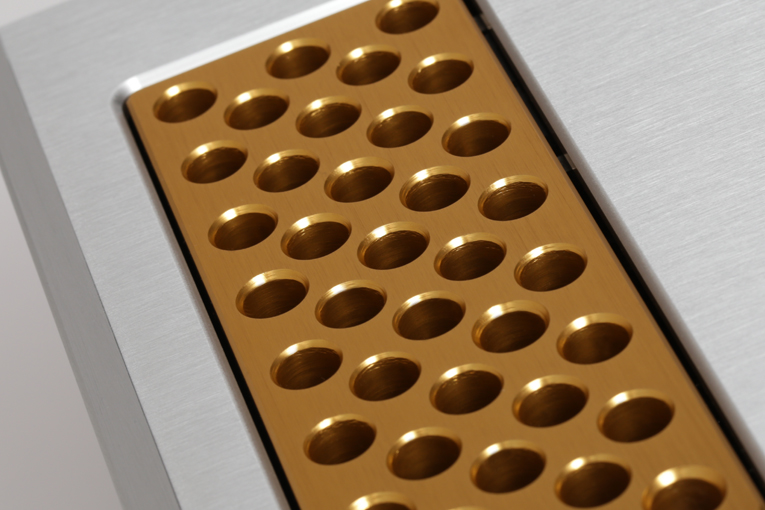
I found the sound of Hegel’s H120 more laid-back than that of the older Hegels or the EX-M1+. I can’t say I preferred the sound of the H120 over the EX-M1+, or vice versa — they just sounded different. But there was no denying that the Kinki’s far greater output power allowed it to better control the two 8″ woofers and electrostatic panel of each of my MartinLogan Classic ESL 9s. At high volume levels, the voice and piano in “Thunder Road” hardened and compressed a bit through the H120, while the greater dynamic abilities of the EX-M1+ made powerful, expansive EDM tracks, such as those on Yello’s Point, sound more balanced from top to bottom.
While the EX-M1+ had a definite advantage over the lower-powered Hegel with the ML hybrid electrostatics, the differences weren’t so pronounced with the more budget-friendly PSB Alpha T20s, which are easier to drive. With speakers that are more likely to be paired with these amps — such as GoldenEar Technology’s Triton Three+ with its powered bass section ($2499.98/pair), or Paradigm’s relatively efficient Premier 800F ($1998/pair), both of which I’ve reviewed — I suspect that these amps would sound more similar to each other than they did when driving the MLs. And keep in mind that the Hegel H120 includes a very capable internal DAC and basic streaming capabilities, both of which I find extremely convenient. The Kinki would require an external source such as the Oppo UDP-205 ($1299, discontinued) and a high-quality interconnect.
The improvements over the EX-M1+ that I heard through the budget Alpha T20 speakers with the Naim Supernait 3 ($4990) and NAD M33 ($4999) I heard even more clearly through the ML ESL 9s. While the sounds of these three integrateds don’t radically differ from each other, the Naim’s richer midrange fleshed out Fred Schneider’s voice in “Love Shack,” from the B-52s’ Cosmic Thing (24/96 FLAC, Rhino/Warner/Qobuz), even if I couldn’t as easily distinguish between the harmony vocals of Kate Pierson and Cindy Wilson in the chorus as I could through the Kinki. The NAD M33 excels at re-creating a sense of space, even more than does the EX-M1+ — the M33’s extremely quiet, neutral sound further delineated not only the singers’ voices but also background noises in the crowd, making for an even more holographic sound.
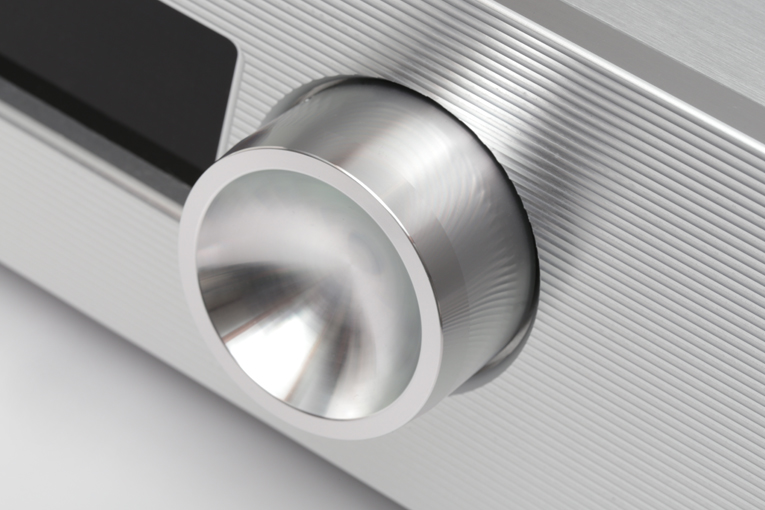
Ultimately, the EX-M1+ couldn’t compete with the more technologically advanced M33 — but the NAD costs $2101 more. I can see how some might prefer the richer, more solid sound of the similarly priced Naim, for $2092 more than the Kinki. But the EX-M1+ is the first integrated amplifier I’ve had in my system that could make my MartinLogan ESL 9s perform to nearly their full potential for such a low price. Every other integrated that has been able to make the MLs sound this good has cost $5000 or more. The EX-M1+ provided a similar level of performance for a little more than half the price.
When I listened to the EX-M1+ through its home-theater bypass, using it as a power amp and my Oppo UDP-205 as a preamp-DAC, the Kinki retained its ultraclean, powerful sound, but lost just a touch of the weight that gives music its remarkable “jump.” With only the UDP-205 directly driving the EX-M1+’s power-amp section, the bass beat of Yello’s “Waba Duba” was slightly lighter, depriving this track of a little of its infectious rhythm — but aural images remained clean and precise on an extremely wide soundstage. When I switched back to one of the Kinki’s variable unbalanced inputs and used its preamp stage, the sound was indistinguishable from the variable balanced input I’d previously been using.
Make this one-plus my plus-one
Kinki Studio’s EX-M1+ is a straightforward, all-analog integrated amplifier whose reasonable price and high power rating might make you think it would produce merely adequate sound. But I found it to provide a stunningly big helping of audiophile sound quality for the price.
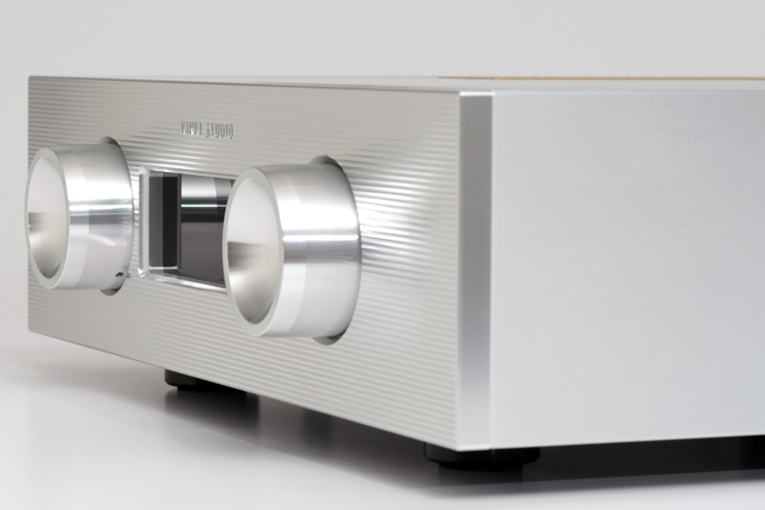
You’ll still have to budget for a very good source component — the EX-M1+ deserves no less — and if you want to spin vinyl, you’ll need a turntable and phono stage. And if you don’t need the EX-M1+’s preamplifier output and home-theater bypass, the less-expensive EX-M1 lacks these features but is otherwise essentially identical and costs only $2398, making it an even better value — in fact, an absurdly good one. Two great deals.
. . . Roger Kanno
rogerk@soundstagenetwork.com
Note: for the full suite of measurements from the SoundStage! Audio Electronics Lab, click this link.
Associated Equipment
- Speakers — MartinLogan Masterpiece Classic ESL 9, PSB Alpha T20
- Integrated amplifiers — Hegel Music Systems H120, NAD Masters M33, Naim Audio Supernait 3
- Sources — Apple MacBook Pro computer running Roon and Qobuz, AudioQuest JitterBug dejitterer, Oppo Digital UDP-205 4K Ultra HD and BDP-105 universal BD players
- Digital link — AudioQuest Carbon (USB)
- Speaker cables — Clarus Aqua Mark II
- Interconnects — Clarus Aqua Mark II, Nordost Quattro Fil
- Power cords — Clarus Aqua, Essential Sound Products MusicCord-Pro ES
- Power conditioners — Blue Circle Audio PLC Thingee FX-2 with X0e low-frequency filter module, Zero Surge 1MOD15WI
Kinki Studio EX-M1+ Integrated Amplifier
Price: $2898 USD.
Warranty: Three years parts and labor.
Kinki Studio Pte. Ltd.
11 Woodlands Close
Singapore 737853
Phone: +65 8850-4635
E-mail: sales.kinkistudio@gmail.com
Website: www.kinki-studio.com






















